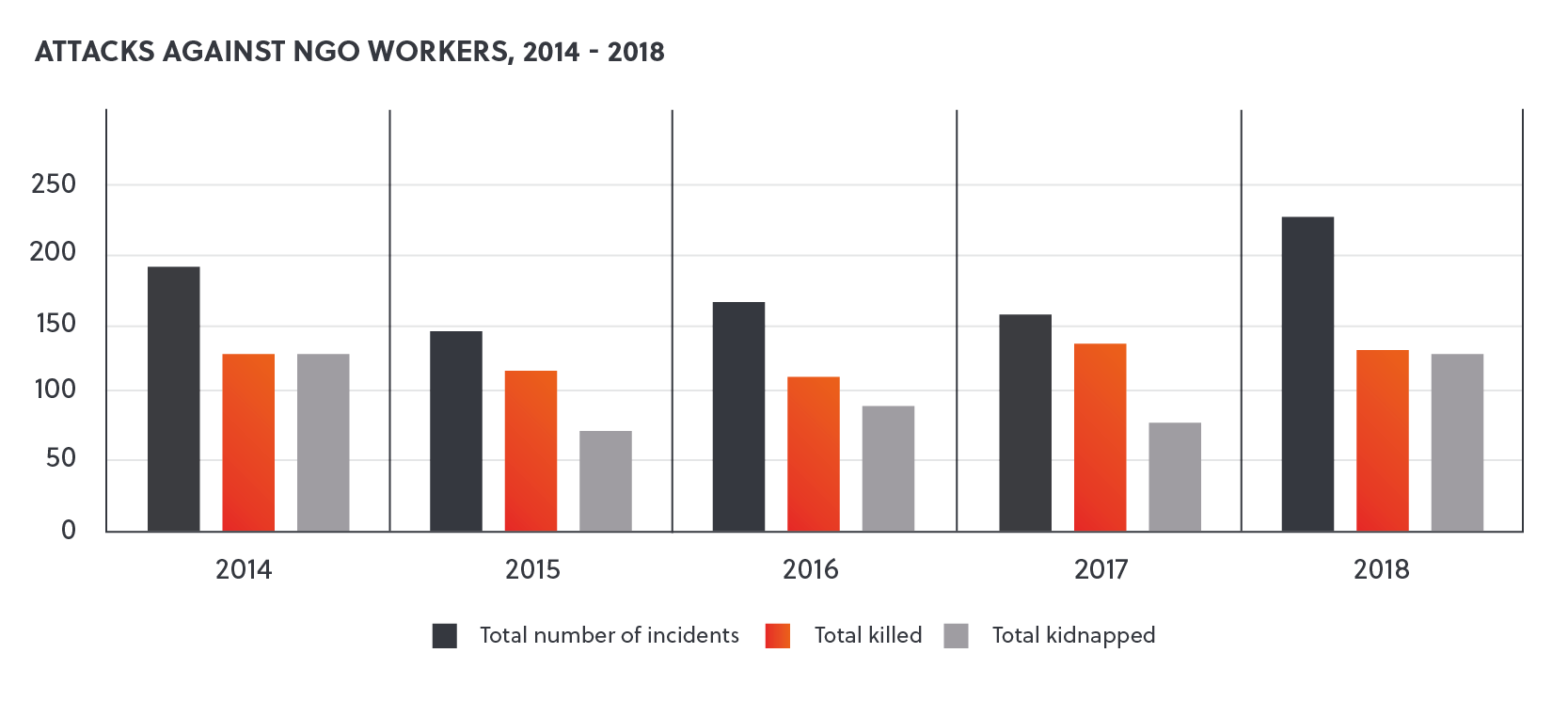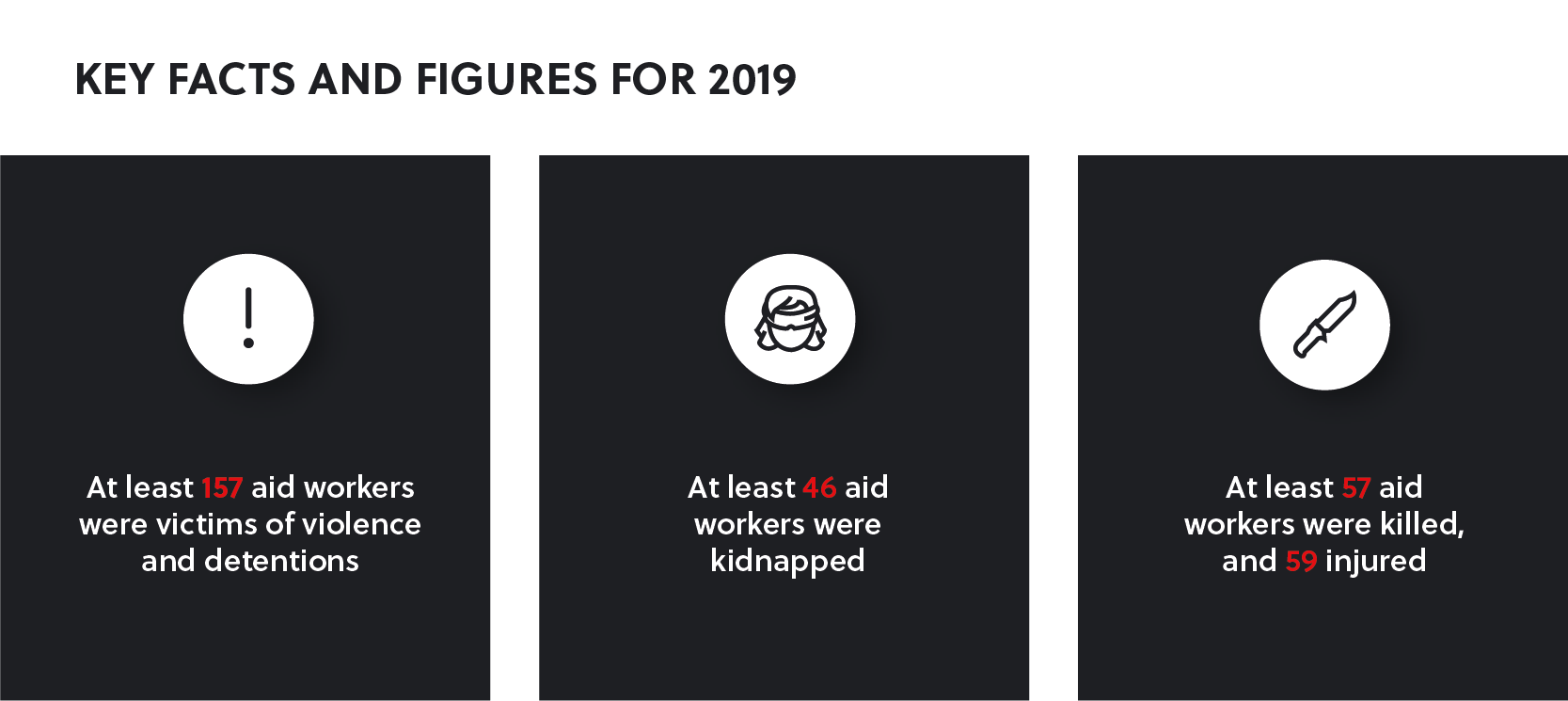Providing Aid in Conflict Environments: Security Threats Facing NGO Workers
Both state and non-state actors have displayed hostility towards humanitarian agencies. In 2018, Humanitarian Outcomes, an independent research organisation, reported the highest number of attacks against aid workers globally over the past five years – including the highest number of kidnappings. Between 2017 and 2018, the number of incidents increased by 43 percent.

While countries experiencing conflict are often in dire need of humanitarian relief, their governments may lack the resources or political will to maintain security and protect aid workers in affected areas. This, in turn, creates a permissive environment in which armed groups, de facto local authorities, and even state actors, can target NGO workers for financial gain or political leverage.

WHY AID WORKERS?
Motivations for violence against aid workers differ depending on the regional or country-level context, and may be financial, political – or even incidental – in nature. In Syria, for example – which recorded the highest number of aid worker fatalities in 2019 – aid worker deaths are predominantly caused by airstrikes. In sub-Saharan Africa (SSA), perpetrators are often criminal gangs, rebel groups or local militias who perpetrate kidnappings for ransom, as is sometimes reported in Nigeria, Kenya and Somalia. According to Gabrielle Reid, a Senior Associate on S-RM’s Africa desk, “community members in a number of SSA countries have also kidnapped aid workers for leverage in local disputes often directed at local authorities – for example, to negotiate the release of an arrested resident who may have been accused of being a militia member.” In the Middle East, kidnappings and attacks are often politically motivated. Houthi militants in Yemen, for example, detain aid workers for leverage in disputes with the international community, having previously accused foreign aid agencies of being used to spy on Houthis and Yemeni citizens in Houthi-controlled areas.
In cases of wrongful detention by government authorities, Reid notes that “aid workers’ activities are often perceived as relating to anti-government activism,” rendering them indirect targets of crackdowns on political dissent. In Equatorial Guinea, staff of a prominent human rights organisation were arbitrarily detained, prosecuted and reportedly assaulted after accusing the government of human rights violations in July 2019. Some detentions also take place amid increased military or counter-terrorism campaigns, for example in Nigeria in September 2019, when the government and military forced the Action Against Hunger aid group to cease operations in north-eastern Nigeria after accusing the organisation of supporting Boko Haram militants.
LOCAL VS FOREIGN WORKERS
Most aid workers targeted over the past few years have been local nationals. In 2018, only around 7 percent of aid workers attacked, detained or kidnapped were foreign nationals, likely due to their far more limited exposure to insecure operating environments. Foreign aid workers are also often restricted in terms of their access to certain areas, especially in active conflict zones where their respective governments have reduced or closed down humanitarian operations.

CASE STUDIES
SOUTH SUDANSouth Sudan remains the most dangerous country for aid workers. As at October 2019, at least 115 aid workers have been killed since the civil war began in December 2013. According to Reid, South Sudan is a complex environment in which to operate as an aid worker. She states that “since clashes broke out between rebel groups aligned with former Vice President Riek Machar, and government and militia forces loyal to President Salva Kiir, the conflict has periodically escalated to the extent that aid agencies have evacuated foreign personnel, including in 2019.” The security environment remains uncertain amid rival factions’ moves towards – and delays in – forming a unity government, which may prompt sporadic escalations in fighting, further endangering aid workers in 2020. Humanitarian workers are often killed or injured during skirmishes between warring parties. In October 2019, three aid workers were killed during clashes between government and rebel forces in Yei River State. Two others were kidnapped during the incident. Aid workers are also sometimes abducted or killed during attacks on their convoys, while transporting supplies to affected areas. Workers and aid warehouses are particularly vulnerable during inter-communal violence, which creates an opportune environment for looting. Aid theft is a persistent problem in South Sudan, where perpetrators seek to control resources and aid delivery. Reid adds that aid workers face additional threats of harassment by local officials: “In June 2019, aid workers reported increased incidents of harassment and detentions at Juba International Airport, while in July, reports emerged of local authorities confiscating humanitarian assets.” |
DEMOCRATIC REPUBLIC OF CONGO“The Democratic Republic of the Congo saw a significant increase in reported violence against Ebola aid workers in 2018 and 2019,” notes Reid. Both militants and local communities in North Kivu Province, where the Ebola outbreak is severe, have targeted Ebola health workers and facilities in 2019, with militants attempting to frustrate aid work, and community members angered at having to burn deceased relatives, rather than bury them according to traditional customs. In November 2019, the World Health Organisation (WHO) and the U.N. Children’s Fund (UNICEF) evacuated around 76 non-essential staff following a series of violent protests and arson attacks against UN compounds in Beni. Community members accuse the UN of failing to protect civilians against an escalation in militant attacks in the area. Since mid-2018, there have been at least 386 attacks, seven deaths and 77 injuries among aid workers operating in North Kivu. The security situation in the province remains subject to rapid deterioration, and attacks against Ebola and other aid workers will likely continue in the coming months. |
AFGHANISTANIn Afghanistan, Taliban militants have both demonstrated and reiterated their intent to continue targeting aid workers and agencies affiliated with the US, often citing these agencies’ allegedly suspicious or anti-Islamic behaviour. On 8 May – amid ongoing US-Taliban peace talks – Taliban militants killed five people and injured 24 others when they attacked the US-funded developmental agency in Kabul, using a vehicle-borne bomb. Taliban spokesman, Zabihullah Mujahid, claimed that the agency was targeted for its US ties, accusing it of conducting ‘harmful Western activities’ in the country. In the most recent attack, gunmen targeted an aid vehicle in Jalalabad in December 2019, killing six people, including a Japanese doctor. NGOs providing medical care, such as the Red Cross and the WHO, have made efforts to negotiate access to Taliban-controlled areas of the country, with little success. The December 2019 attack took place despite Taliban leadership’s decision to lift a ban on Red Cross operations in Taliban-controlled areas in April; this highlights the reality that militants often fail to adhere to high-level decisions taken by their groups’ leadership, resulting in a highly volatile operating environment. |
Read our 2020 Travel Security Special Edition for more global security insights.
